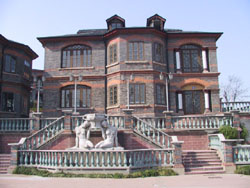 |
The Zhenjiang Museum, situated at Boxian Road of Zhenjiang City in Jiangsu Province, was constructed in 1958. It consists of a group of five Italian-style buildings. Its elegant, red and black brick architecture covers an area of more than 3,000 square meters with 1,000 square meters for exhibition. Set on Yuntai Mountain, the building offers a fascinating view over both the city and the river. The interior is well preserved in its original style with wooden stairways and floors. The Museum is definitely worth a visit.
The Museum houses more than 30,000 Chinese historical relics, from the Neolithic Age to the Qing Dynasty (1644-1911), and about 100,000 ancient books. Among them are one national treasure, and some 70 first-grade national cultural relics. The Museum's main exhibits are of Western Zhou Dynasty (11th century BC-771BC) bronze wares, celadon from the Six Dynasties (220-589), gold and silver wares from the Tang (618-907), Song (960-1279), Yuan (1271-1368) and Ming (1368-1644) dynasties, and works of calligraphy and paintings from the Ming and Qing dynasties.
Chinese bronze wares are national and world treasures. Those from different regions each have their distinct characteristics. Zhenjiang bronze wares are small and, with their simple designs and patterns, refined. The Museum's phoenix patternedZun(a kind of ancient wine vessel) is a national treasure. Its body is imposing and heavy, and the phoenix motif decorating the vessel adds vitality to its stately magnificence.
A bird-lidded coverHu(wine pot) with stylized animal mask design is another of the Museum's treasures. It is 49 cm tall, and its lid is fashioned in the form of a bird in flight, giving this heavy vessel a lighter aspect. It is said that there was still liquid in this vessel when it was unearthed.
A five-piece Song Dynasty clay sculpture set depicts five boys. The sculpture was not glazed but subtly painted so as to emphasize the innocence, intelligence, and essential vitality of these children. One boy has fallen to the ground, but seems unworried. The second one lies prone, his rump proudly raised. The third looks to be acting as referee, as the fourth squats comfortably, and the fifth looks on with folded arms. Seals denoting the craftsmen's name, place and time of production were clearly visible when these sculptures were unearthed, adding further to the set's historical and cultural value.
The Zhenjiang Museum carries out regular exchange activities. It has been involved in exhibitions held in other cities in China and abroad, helping to promote China's cultural exchanges with other countries. For instance, in recent years it organized the Zhenjiang Cultural Relics Exhibition, the Wu Culture Archaeological Discovery Exhibition, the Tang Dynasty Gold and Silver Wares Exhibition, and the Zhenjiang Ancient Costume and Silk Exhibition in Beijing.